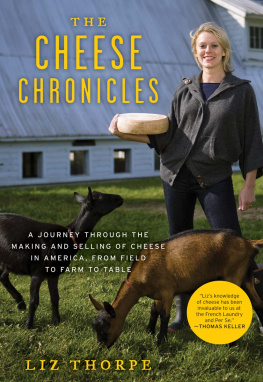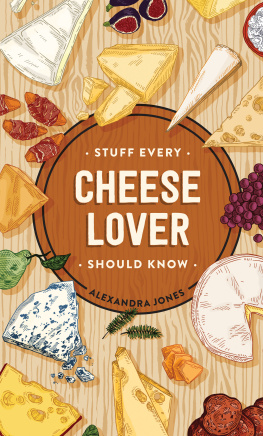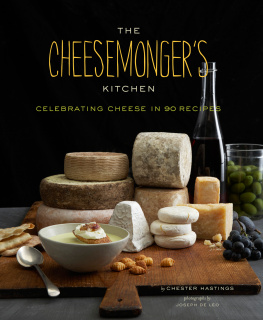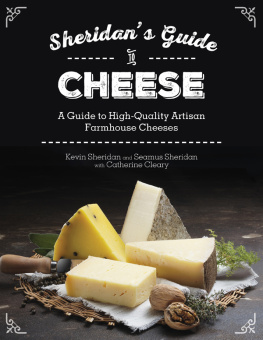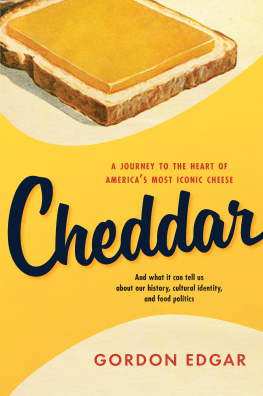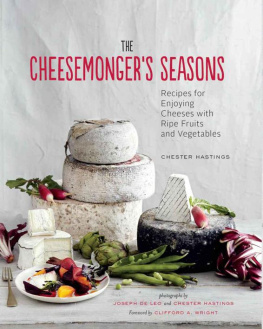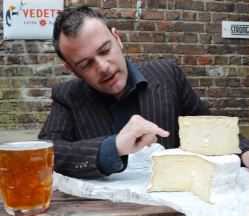
Ned Palmer first experienced great cheese at Borough Market, helping to sell Trethowans Gorwydd Caerphilly (still one of his all-time favourite cheeses). He then learnt his craft at Neals Yard Dairy, who dispatched him to farms and dairies across Britain and Ireland. It was during one such visit, to Mary Holbrooks farm in Somerset, that he came up with the idea for a Cheesemongers History, realising that her fresh Sleightlett cheese was just what a Neolithic farmer would make. There followed many more trips from Hawes Yorkshire Wensleydale to Milleens at the tip of County Cork as well as long hours in the British Library, immersed in Celtic cheese folklore, monastic account books and unearthing tales of cheese piracy, cheese magic and Queen Victorias giant birthday cheddar.
Ned lives in London with his wife, the novelist Imogen Robertson, many, many books about cheese, and a piano. He set up the Cheese Tasting Company in 2014, to spread the gospel.
Author photo: Katheryn Bromwich
Acknowledgements
Without the cheesemakers, I wouldnt have had anything to write about, and my gratitude to all of them, not just those mentioned in this book, is boundless. There are too many to fit in here so let me confine myself to this: if you make cheese, thank you, and please carry on. If I were to single out any for special thanks it would be the late Mary Holbrook, the first cheesemaker to let me get my hands into a vat, and in whose kitchen I came up with the germ of the idea for this book. Thanks Mary, I hope there are goats and cheese vats wherever you are now.
Special thanks, too, to Gorwydd Caerphilly and the craft and dedication of its makers, Todd, Maugan and Kim Trethowan, since it was the first taste of that cheese that set me on the path; and to Jess for introducing me to the Trethowans and their cheese and, almost twenty years later, to Jill and Mark Hatch who patiently answered my questions about Neolithic cheesemaking.
Im hugely grateful to those cheesemakers who let me into their dairies or allowed me to bombard them with questions over the phone: Quinlan Steele of Milleens; Sarah and Paul Appleby, Aunt Sarah and Garry Gray of Applebys Cheshire; Joe Schneider of Stichelton Dairy; Tom Calver of Westcombe Dairy; cheese educator Val Bines; Humphrey Errington of Erringtons Cheese; Carrie Rimes of Cosyn Cymru; Marcus Fergusson of Feltons Farm; and Dave Holton of Blackwoods Cheese Company.
I also want to say a heartfelt thanks to the cheesemongers who made me what I am: Cathi, Sylvie, Viv, Matt Owen, Evin, Chris George, Bill and of course Randolph Hodgson, without whom, etc. And to all those friends in the writing fraternity who offered advice, support, or an empathic ear, in particular Alex von Tunzelman, Robyn Young and Kate Williams.
This book would have never made it out of the back-of-a-fag-packet stage without the initial enthusiasm and tireless championing from my agent and cornerman David Luxton. It would have been a lot longer and less readable without the skill and experience of my brilliant editor, Mark Ellingham, and the diligence and rigour of Jonathan Buckley, and suggestions from Nat Jansz. Thanks for the arresting cover design and lavish endpaper map to David Wardle of Bold & Noble; to Henry Iles for the text design and layout and the photo treatments; to the eagle-eyed Nikky Twyman for correcting my wayward spelling and grammar, and saving my bacon; and to Bill Johncocks for the thoroughness of the index. On the marketing, publicity and sales front, thanks to Flora Willis, Anna-Marie Fitzgerald and Jane Pickett, and to Claire Beaumont and her team. In fact I want to thank everyone at Profile; there cant be many publishing houses where you are greeted with such hospitality and friendliness even when you dont bring cheese.
Straddling effortlessly that fraught boundary between friendship and professionalism, Nausicaa Ramerino and Tam Cooper did a great job of translating some medieval Italian cheese writing. I am also blessed with too many wonderful friends to thank individually for their loyal and occasionally tough advice (just get up earlier, Ned, being a fine example). Thank you all. I do want to mention two people, Rosalind Graves Cooper and Gabriella Oakley who, a very long time ago indeed, knew that I could and would before I did.
My dad, Greg Palmer, took me into the stacks of the British Library to help him at the National Archive when I was very small. Thats probably where all this started. My mum, Ann Palmer, showed me how to string a sentence together and most of the time picked my pen up when I chucked it across the room.
And then there is my first reader, sternest critic and biggest fan, my best friend and wife, the brilliant writer Imogen Robertson. Thanks Imo.
A BRIEF DIRECTORY
Some favourite cheeses
At last count, there are about 800 different cheeses being produced on a regular basis in the British Isles. Some are only available in small batches, sold locally. But most can be found at specialist cheese shops. Below are some personal favourites. You can also find an ever-expanding version of this list on my website, www.CheesetastingCo.uk, along with links to the producers and a directory of specialist shops.
Fresh cheeses
This style of cheese employs the simplest and most low-tech method. Milk is soured and set and the resulting curd ladled into moulds with little if any more intervention. Served at anything from a day to not much more than a week old, these young cheeses have a delicate clean flavour such that they are best eaten earlier in your cheese session before more mature stronger styles. So as not to overwhelm their gentle flavour I would pair them with more subtle drinks. Crispy floral white wines or light jammy reds make considerate partners. Their soft texture also responds well to a quality lager or, if youre feeling expansive, champagne.
Caboc and Crowdie
Made by the Stone Family at Blarliath Farm, near Tain, Ross, Scotland.
Pasteurised cows milk, veg. rennet.
Crowdie, made with skimmed milk, is a light soft cheese. Its more opulent sister cheese, Caboc, enriched with extra cream and rolled in oats, has an enticing yellow colour and tastes like slightly tangy clotted cream. According to legend this cheese was first made by Mariota de lIle for her father, the chief of the MacDonald Clan luxury full cream cheeses were the perks of the rich in the old days. Happily in this more democratic age, Caboc is available to all.
Perroche
Made by Charlie Westhead and his team at Neals Yard Creamery, near Dorstone, Herefordshire, England.
Pasteurised goats milk, veg. rennet.
A cheese so simple and delicate that it welcomes added flavourings. Perroche comes rolled in herbs like rosemary or dill, or in a plain version, to which you could add your own flavours smoked paprika, roasted garlic or crumbled honeycomb are three of my favourites. That is not to say that, with its citrussy flavour and moussy texture, it cannot be enjoyed as nature intended. Big bold New World reds can work with this cheese, its bright acidity bringing out their dark fruit notes.
Sleightlett
Made on Sleight Farm, near Bath, Somerset, England.
Unpasteurised goats milk, animal rennet.
Small snowy discs with a dusting of ash, these cheeses are best enjoyed before they have had time to develop a rind and, like most goats milk cheeses they are only available for a limited season from early spring to autumn. Although they are firmer and more strongly flavoured than Perroche, Sleightletts have only the merest hint of goatiness about them, making them excellent starter cheeses for the novice goat fancier.
Next page

